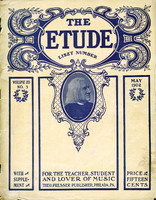Attention is again called to the questions which, beginning with the April, 1902, issue of The Etude, will be discussed under the above caption. Again it may be advisable to emphasize the fact that the majority of players are wholly uninformed on numerous questions appertaining to the violin and to violin-playing. The average pupil does not concern himself with questions that have not a direct bearing on the work in hand. Nor does the average teacher make any effort to arouse in his pupil the desire to be well informed. As a natural consequence, the typical student of the violin imagines that he is faithfully performing his musical duties when he attends all lessons regularly and devotes a certain number of hours each day to purely instrumental work. He imagines, indeed, that he is an earnest and painstaking student; and he never suspects, even for a moment, that there are many interesting things deserving his attention that are never discussed in the class-room.
It is earnestly hoped that this new column will appeal to all readers of The Etude who are interested in the violin. And it is also hoped that these readers will make a special effort to acquire some knowledge in connection with the various questions touched upon in each issue, and that they will not remain uninterested and inactive, calmly awaiting the information which they will find in these columns.
The answers to the six questions asked last month are as follows:
- The thicker the string, the fewer will be its vibrations. A string that vibrates rapidly (necessarily a thin string) produces a high tone, whereas a thick string is capable of fewer vibrations, and produces, in consequence, a lower tone. An uncovered string, of the requisite thickness to produce the tone G, would be entirely too thick for all practical purposes; so, in order to avoid the use of an exceedingly thick string, a thin one (generally, or always, an A string) is increased in weight by means of a metal covering, and this additional weight diminishes the number of the string’s vibrations.
- The design of the modern bridge is not the result of accident. Stradivari’s predecessors experimented unsuccessfully with various designs; but it was left to Stradivari’s genius to determine the ultimate form of the bridge. This the great Cremonese master succeeded in accomplishing with such scientific precision that it has been found impossible to make even the slightest improvement upon his ideas.
- “The f shape of the sound-hole,” says Mr. Allen, “is rendered necessary by the arching of the belly. They influence the entire system of vibrations of the belly, and thus govern the vibrations of the whole instrument. This has been proved by the following experiment: if the ff-holes were cut in the back of the fiddle, it would be immediately muted, for the belly would not have sufficient elasticity without them to vibrate and communicate its vibrations to the rest of the instrument… . The ff-holes influence to a powerful degree the sound of the mass of air contained within the body of the instrument. If they are too small, or if one be covered up, the sound of the contained air becomes lower; if they are cut too large, it rises. The ff-holes must, therefore, be regulated by the size of the fiddle, and the proportion of the ff-holes must be so adjusted that the contained mass of air renders the requisite 512 vibrations. If they be too large, or set too near to each other, the tone of the violin becomes harsh and shrill, and when too small, or set too far apart, they make it more wooly or viola-like.”
- A “wolf” tone is generally the result of an imperfect adjustment of some of the delicate parts of the instrument. It is a tone of imperfect vibration, exceedingly annoying and disagreeable. It is usually found on the G string, often on either f-sharp or g-sharp. A “wolf” tone frequently mars the beauty of a fine old instrument, and fiddle-makers are not always successful in removing the cause.
- This question has already been answered in the remarks on the G string.
- By a “baked” fiddle is meant an instrument whose wood has undergone a baking or preparation process. By such a process, an instrument, when absolutely new, resembles in mellowness one that has been played upon for many years. The celebrated French maker, Vuillaume, practiced this deception for many years, and ruined many of his instruments.
The greatest practical adepts in any art are not, by any means, always the best teachers of it, not merely from lack of necessary patience, but from want of power in imparting knowledge. The hone, which, although it cannot cut, can sharpen the razor; the finger-post that shows the way which itself can never go, are emblems of the teacher. It is only by a fortunate coincidence that the capacity for teaching, which is an art sui generis, and practical excellence of execution, are found in the same individual. —Mackenzie.
That which we feel we know, but are not so certain of that which we see.
Certain men, in history, appear destined to work in their sphere, the point above which no man can go. Such was Phidias in sculture (sic) and Molière in comedy. Mozart was one of these men.—Gounod.



